The Secret Love Life of Dolphins and Whales
In Part Two of their interview, Anne Gordon de Barrigón of Panama Whale Watching Panama/ Emberá Village Tours reveals to Jet Metier the highly tactile and social qualities of dolphins and whales, and when it comes to forgiveness, how their hearts maybe bigger than their legendary brains. 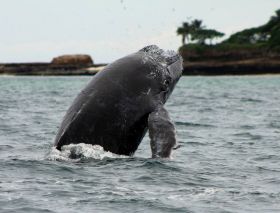

Jet: How do think the orcas feel about you, Anne?
Anne: [laughing]
Jet: How would you categorize them as you would people? For instance, if you were to characterize a dog, you would say that they’re dependable, they’re loyal, they want to play and they want to sleep. So what are the characteristics of orcas, so we can understand them as personalities?
Anne: First of all, every animal has an individual personality.
Jet: Oh, yes, yes.
Anne: Just like you and I do.
Jet: Yes.
Anne: But that goes not only for dogs, but also for chimps, tigers and orcas and all of the others.
Jet: And you’ve known a lot of personalities.
I have, human and non-human. And then each species has their own general personalities: traits as you were mentioning, the dog. Orcas are super intelligent.
Jet: How can you tell they are intelligent?
Anne: Some people feel orcas are more intelligent than humans, which I tend to believe. If you just look at the physicality of it, their brain to body ratio is larger than ours. And they have more cortical folds, so more surface area on their brain, which is believed to be linked to intelligence. They are fascinating. They are very family-oriented. They are in matriarchal societies their entire lives, and very loyal.
Jet: They live in matriarchal societies, so for lack of a better word, what about the young bucks when they want to find mates? Do they bring other female orcas into their pods?
Anne: Nope. They all stay in their own pods forever. The males never leave their mothers’ side ever, their entire lives. But--
Jet: Who do they mate with Anne?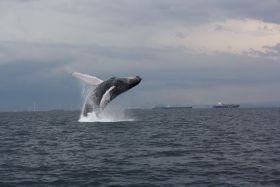

Anne: I’m getting there. If you have a pod of orcas, say for example, in Puget Sound, you have three resident pods: “J”, “K” and “L” pods. And J, K and L pods often come together in big social groupings; parties as it were…
Jet: Ah, ha!
Anne: And that’s when you get the mating going on.
Jet: What is the courtship like? Do male orcas perform to get the attention of the female orcas?
Anne: Well, that’s a good question and I don’t know if anybody knows the answer to that. Dolphins and whales spend 90% of their lives under water, so there is a whole heck of a lot we don’t know.
Jet: What do you know about their mating habits? What have you seen?
Well, you do see mating. Dolphins are not shy about mating right in front of you. I’ve had them swim ten feet from me, mating.
Jet: [laughing] Do they do it is this doggy-style?
Anne: No, they are belly to belly.
Jet: Belly to belly, I see. That's very romantic. But what about the dolphin on the bottom. Aren’t they drowning? [Laughing]
Anne: No. They are holding their breath. And there is no weight, because they are under water, so nobody is getting schmushed. It doesn’t matter who’s on the top or who’s on the bottom.
Jet: Are they waving at you and showing off?

Anne: I think they do; I think they do. When they come that close to you and they are doing it: it’s like it’s purposeful.
Jet: [Laughing] It’s porpoise-ful. That’s beautiful that they believe in expressions of love.
Will they have mates for life?
Anne: No. The orcas stay with momma forever. But they don’t mate for life. The dolphins are one of the few species besides man who have sex for the sheer joy of it.
Jet: Oh, my! It’s a pleasure bond, too.
Anne: Exactly, it’s a pleasure bond and a re-affirming or friendship and bonding. It’s not necessarily opposite genders either.
Jet: Oh, the mind boggles!
Anne: [Laughing]
Jet: Let’s go back to the whales for just a second. We’ll hold off on the dolphins. They mate with L, K and J pods. So they have their big social. Are they mating with everyone at this party? Or do they go elsewhere and have a private tête-à-tête?
Anne: There is nothing to be ashamed of for them. So there is no hiding it.
Now you said leave the dolphins for a minute. I need to clarify: orcas are technically dolphins and they are the largest member of the dolphin family. They are not whales at all. So there you have it.
Jet: In the subcategory of orcas, do the males fight amongst themselves for the females? Do you see any battles?
Anne: I don’t know if they do or not. We rarely have orcas in Panama. So we don’t see them here. Here we have humpback whales. And they do have, what we call “rowdy groups. “ Males will fight with each other and push and shove and vie for the attention of the female.
Jet: Is it many males for one female or is it just usually mano a mano with two whales?
Anne: It’s many whales. I’ve seen as many as eight to ten males fighting each other for the attention of the female.
Jet: Wow!.JPG)
.JPG)
Anne: Nobody knows how the choice is made; whether one dominant male, the strongest male, say, vanquishes all the other suitors or the female decides, “No, I like you. I’m going with you, and all the rest go away.” We don’t know the answer to that question.
Jet: It is such a mystery. Do you remember that lion in a zoo, and he had only one blind eye, and he was old and ratty. He had quite a harem. And the young bucks couldn’t get anywhere near the females.
Anne: That is pretty typical lion behavior. They are extremely territorial and extremely possessive. So if he’s got the dominance, yeah, there is no way any other boy is going to get in there.
Jet: So when the orcas have their night of romance, and then they go back to their mothers, the females go back to their original pods, too.
Anne: Correct.
Jet: Can we determine if the female is gestating; that she is pregnant?
Anne: If she’s on the verge of giving birth, yah. She’s big and fat.
Jet: [Laughing]
Anne: If she’s just a few months along, no, we can’t tell.
Jet: So have you seen the birth of a baby orca?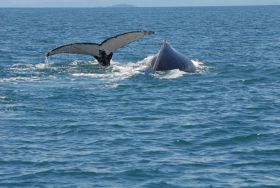

Anne: I don’t know if anyone ever has in the wild.
Jet: Oh really. That would be something.
Switching subjects, when the orcas travel, do they go in military formation? Do they have positions that they all carry, or is it just random?
Anne: I wouldn’t call it military formation and I wouldn’t call it random. It’s more… it’s family style. It’s like yes, the males, you know, protect, but also, they are the strong ones and they make sure that everyone is okay. But, it’s momma that rules the roost, or grandma.
Jet: How can you tell?
Anne: Because the scientists have observed this behavior over and over again. It was all matriarchal and looking at photo ID’s and documenting babies when they are born 30 years ago are still with their mothers.
Jet: The matriarch is in the position of power, where she directs things. Can they tell something like that? That she’s giving the orders for travel or allocation of resources or anything like that?
Anne: Well, not allocation of resources, because they are all kind of fishing together. But basically, if say, the matriarch of the pod, she wants to do something, and she wants to leave, then she just takes off, and then everybody else follows.
Jet: Okay, so that makes it clear. Because when you think of other matriarchal groups, the division of labor is such that maybe the males stay with the matriarch, but when it comes to deciding what territory, or who gets the biggest portion of the plankton?
Anne: Well, orcas don’t eat plankton. They’ll eat salmon. In Puget Sound, they are generally feeding on salmon.
Jet: Yes, what do they eat during their migrations?
Anne: Well, it is all very different. The orcas in Puget Sound, the resident pods are salmon feeders. The transient pods and some of the outer oceanic pods of orcas, they actually feed on seals, sea lions, dolphins and larger whales.
Jet: That right there is fascinating. Why do they do that?
Anne: You have to ask them. It’s just taking advantage of different feeding opportunities and niches, so they are not competing directly. And then there are orcas in New Zealand, and they mainly feed on stingrays and sharks.
Jet: But the transitory ones seem to me that they are more aggressive because they are eating dolphins…
Anne: Yeah, they are a little more predatory.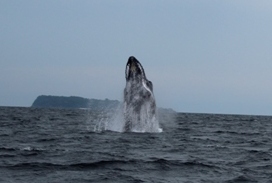

Jet: Do you think that changes people’s ideas about orcas when they learn that the orcas are eating baby seals?
Anne: Then the people would be anthropomorphizing. To the point, you’ve got to realize that, yeah, they are eating a cute baby seal, but on the other hand, if nobody eats cute baby seals, then there would be too many seals, and they are starving to death. And there is no fish. It’s the balance of life; the circle of life. And we have to look at it in that big picture. Not about what we decide is cute and what they shouldn’t do.
Jet: Have you ever observed orcas curious about human beings and trying to be helpful to them? Are there any stories of orcas saving drowned sailors or people who are lost at sea?
Anne: Yeah, I mean, there are stories of orcas, of dolphins, and other whales, absolutely, guiding ships out of danger.
Jet: How do they do that? What would be the danger? (I was going to ask you about the dolphins, not the orcas, but what do I know?) But how would they communicate to us that they want to help us and that they know something that could be helpful?
Anne: Well there are a couple of stories of, I think it was (I don’t remember), I think it was a pilot whale, or something, in a bay that was traditionally quite foggy, and that this whale would generally turn up whenever a ship was entering the harbor, and the ships learned to follow him for safe passage.
Jet: So beautiful!
Anne: An then there is another story of a solo sailor, sailing around the world as part of a race, and he was south of New Zealand, and it was a bit foggy, and a pod of dolphins came up and started riding the bow of his boat, which was very common, and then they all took off to the right. And then they came back and started riding the bow of the boat and then took off to the right. And this happened over and over.
And he’s like, “that’s really weird behavior. Why are they doing that? They either ride the bow or go away, and that’s it.” 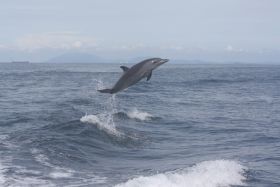

Jet: Over how long of a period of time was this happening?
Anne: They kept on doing this over five or six times.
And he’s like, “this is really strange.”
So he decided, “Okay, I’m going to go to the right with them.”
And it turns out he was off-course a bit and if he had stayed on his course, he would have crashed into the rocks.
Jet: What do you attribute that to? Why do you think they would care about us?
Anne: Well that’s the really fascinating part. They are amazingly altruistic to humans, despite the fact that humans have traditionally, in many cases, been very, very horrible and abusive, you know.
Jet: It breaks my heart.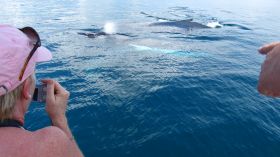

Anne: Yeah, there is a lot we can learn from them.
Jet: So what do you think it is, Anne? Are there any folk tales or anything like that? Has anybody posited anything?
Anne: Well, there are all kinds of things, yeah. Basically, the way I look at it, they look at life, the big picture, much more than we do. They’re not looking at greed or what’s in it for them. It’s all about forgiveness and love, where we should be coming come.
Jet: How do they show forgiveness?
Anne: By just that. Here’s a real good example. Gray whales in Baja California were one of the most highly endangered, hunted almost to the point of extinction by whalers, and they were actually known as one of the most—they were known as devil fish, because they fought and defended themselves so aggressively against the whalers.
Jet: When was this?
Anne: It wasn’t that long ago. I think it was the last whaling in the ‘70’s.
Jet: Oh, okay, uh, huh.
Anne: But now in the very same lagoons that were whaling bases are now where people flocked to take a tour and these very same, some of these very same individual whales are now coming right up to boats, bringing their brand new little babies up to the boats and letting people touch them.
Jet: Oh, how beautiful. Ohhhh…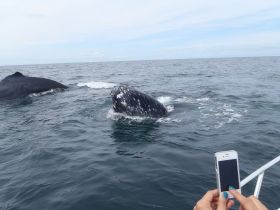

Anne: If that doesn’t say a whole lot about forgiveness, I mean, how many humans do you know if we had been hunted by whales, would you bring your babies to let whales touch you?
Jet: And you wonder, what was their transition when they felt they could do that?
Anne: Right. I don’t know. When the first time it ever happened was a local Mexican fisherman, and he was terrified, and he thought that the whales were coming to attack him. And then the whale was really gentle and rolling on its belly, and just real gentle around the boat. So he reached out and touched it. It was not a problem.
Jet: When you said he was rolling on his belly, does that mean that he upturned himself so that his belly was exposed?
Anne: Yup.
Jet: Like a little doggy?
Anne: Yup.
Jet: Have you met these whales in Baja California?
Anne: No, I haven’t. I’m dying to..JPG)
.JPG)
The interview continues in Part Three in which Anne Gordon de Barrigón delves deeper into the submerged world of dolphins and whales and Jet Metier asks questions about their strong morning breath.


